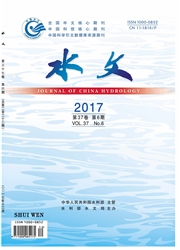

 中文摘要:
中文摘要:
由于受人类活动和气候变化的影响,水文序列失去了一致性。为了适应变化环境对灌溉、供水工程设计的要求,提出了基于典型解集模型的非一致性年径流过程设计方法:首先,采用水文变异诊断系统对径流序列进行年际和年内分配情势变异分析;其次,根据年际变异和年内分配情势变异的时间点,将径流序列分段;再次,基于径流年际变异诊断结果,采用变化环境下非一致性水文频率计算方法计算年径流变异前后过去、现状或未来水平年不同保证率下的设计年径流值;最后,基于径流年内分配变异诊断结果,在径流年内分配变异前后利用典型解集模型进行年径流过程设计。以东江河源站为例,进行了非一致性年径流过程设计,并与未考虑“非一致性”影响的年径流过程设计结果进行比较,发现河源站设计年径流过程受“非一致性”影响显著。
 英文摘要:
英文摘要:
Owing to the effects of human activities and climate change, the natural hydrological series lost their consistency. In order to adapt to a changing environment demanding for irrigation and water supply engineering design, typical disaggregation method for inconsistent annual runoff process design was proposed. Firstly, the hydrological variation diagnosis system (HVDS)was used to analyze the variation of the annual average flow series and their annual distribution features. Secondly, according to the variation point, annual average flow series was divided into several time periods. Thirdly, the frequency distributions of annual average flow series before and after the change-point were conducted based on the hydrological frequency calculation theory for inconsistent series (HFCT) and the difference of means and various frequency characteristic values were analyzed. Finally, typical disaggregation model was used to calculate the annual runoff process in each time period. This study was applied at the Heyuan Station of Dongjiang River, and the inconsistent annual runoff process was designed. The difference of designed annual runoff process before and after the change-point at the Heyuan Station was analyzed.
 同期刊论文项目
同期刊论文项目
 同项目期刊论文
同项目期刊论文
 期刊信息
期刊信息
